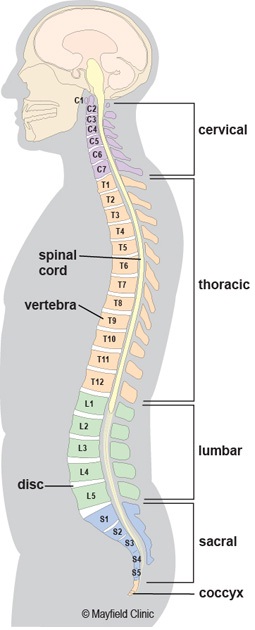by Alan Jordan
An illustration of the entire spinal column can be seen below.
Anyone who suffers from chronic back pain will be keen to know exactly where his or her pain is coming from, and as such, what is causing it. In this day and age, with the advances in medical science, it is hard to believe that there are any health questions doctors don’t have the answer to! However back pain is one of those subjects that, in many cases, leave doctors unable to give patients specific answers as to where the pain is coming from.
The Structure of the Spine
Easily recognised, the spinal column comprises of vertebrae (bone) that are separated by discs (cartilage). Located at the rear are the spinal joints, with most of the muscles being attached to the rear area.
Injury to any area of the spine, whether to the vertebrae, the discs, the muscles, the ligaments, the attaching tendons, the joint capsules, the vessels or the nerves, can result in pain. Further complicating the situation is that most injuries involve several of these tissues, rendering it nearly impossible to pinpoint which tissue is causing the pain.
Can Diagnostic Imaging Help?
Xrays, CT and MRI scans are invaluable in the diagnosis of many health conditions, however when it comes to spinal pain only around 15-20% of patients will have diagnosis and treatment based upon the findings of diagnostic imaging. Generally these cases involve more serious injury, such as frank disc prolapses, tumours, infections and other inflammatory conditions. The majority of patients will have imaging to ensure that none of these serious conditions are causing the back pain, which is most useful, but does not lead to a firm conclusion when they are not.
Non Specific Back Pain
Non-specific lower back pain is the most common diagnosis for lower back pain. As the name indicates, it is a pleasant way of saying that we simply don’t know what exactly is causing the pain.
However, that does not mean that we don’t know what treatment is the best to use, but of course treatment results would be much enhanced if there were more accurate methods of diagnosis.
Due to the difficulty in diagnosis, patient response to treatment varies. Some patient’s respond well to muscle manipulation and massage, some do not. For certain patients acupuncture may be helpful, but not all.
Working Diagnosis
Monitoring whether a treatment is appropriate for a given patient means firstly determining whether or not they are suited to your form of treatment. If within a predetermined time frame (7-10 days) expected progress is not achieved then patients should be referred to another practitioner or chiropractor. It is for this reason that we have a broad array of health disciplines at our clinic. In fact, at Broadgate, we offer each and every form of therapy that the National Institute for Clinical Excellence recommends.
In addition we have a group of Medical Consultants on staff comprising of rheumatology, spinal surgery, sports medicine and neurology experts, if further investigations and/or second opinions are necessitated.
We are proud of the service that we are able to provide in one setting. Patients are treated with expert care and are fast-tracked to other care as necessary. If you would like to speak to one of our specialists about your back pain or back condition, call us on 020 7638 today.
More information can be found in the Broadgate Spine Journal.





